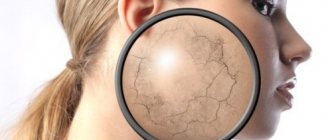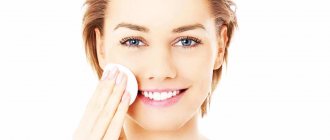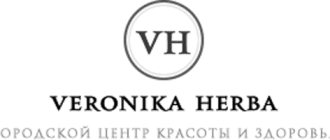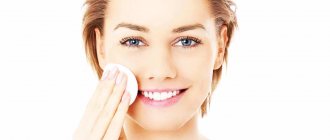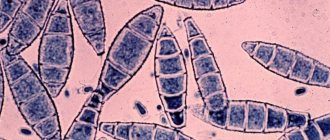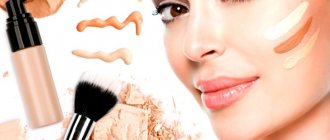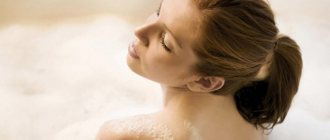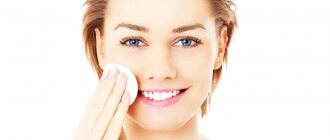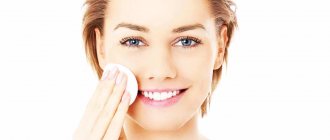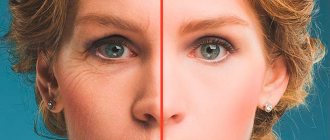Dermatovenereologist (cosmetologist)
Baichorova
Marua Azretovna
21 years of experience
Dermatologist (cosmetologist)
Make an appointment
The constant process of skin renewal can cause blockage of the sebaceous glands and follicles. Getting into microscopic holes, excess sebum and dead cells of the exfoliated epidermis lead to the appearance of blackheads or pimples. Experts have united them under the name “comedones”. The situation is aggravated by the lack of proper skin care, exposure to unfavorable sanitary conditions, as well as the intense production of sebum, the excess of which clogs the ducts and hair follicles.
The vast majority of cases of comedones are observed on oily facial skin: on the nose, forehead and cheeks. According to most medical specialists, such a pathology is true evidence of hormonal imbalances, hidden dermatological problems and malfunctions of the liver and gastrointestinal tract. Therefore, patients who experience discomfort from their appearance are advised not to focus on the cosmetic problem, but to undergo a comprehensive examination to identify possible diseases of the internal organs.
Etiology of the disease
The opinion that comedones appear only in adolescents and young adults is not entirely true. They occur in up to 85% of patients under 25 years of age, after which sebum production decreases and the conditions for blockage of the glands disappear on their own. Also, women often suffer from the disease during pregnancy and at the onset of menopause, when the body experiences a significant hormonal load. The intensive development of the disease can be caused by unsanitary working or living conditions, lack of proper skin care, neglect of hygiene rules and other reasons due to which the adverse effects on the skin of the face acquire such unpleasant consequences. Refusal to treat comedones can cause the formation of scars and age spots at the site of the rash, which can only be eliminated using plastic surgery methods.
Results
- Comedon is a type of acne. It is a cyst that occurs against the background of blockage of the mouth of the hair follicle; it can be closed or open.
- To create homemade acne masks, pharmaceutical products and food products are used that have a cleansing, drying and anti-inflammatory effect.
- The most popular ingredients are clay, egg white, honey, gelatin, rice, potatoes, cucumber, oatmeal and kefir.
- Cosmetic procedures to combat and prevent the appearance of comedones are used in a course lasting up to a month. The optimal frequency of application is 2 times a week.
Reasons for the formation of comedones
A black dot or raised white spot on the surface of the skin is excess sebum that is stuck in the sebaceous duct or inside the follicle. The resulting plug disrupts the functioning of the glands and forms a closed environment, ideal for the proliferation of pathogenic microorganisms. Their vital activity “enriches” the plug with toxins, which causes a local inflammatory process and its subsequent spread to healthy areas of the skin.
Among the reasons causing the appearance of multiple comedones on the face, ears or back, experts call:
- hyperactivity of the sebaceous glands;
- use of low-grade cosmetics;
- lack of proper facial care, as a result of which excess sebum and epidermal cells remain on the skin;
- refusal to remove traces of cosmetics before bedtime;
- smoking;
- living or working in an environment characterized by the presence of dust and small particles of dirt in the air;
- unbalanced diet, dominated by fatty, smoked and spicy foods, sweets and flour products;
- deficiency of microelements and vitamins.
A comprehensive examination of the body of a patient complaining of open and closed comedones often reveals hidden pathologies of the following nature:
- liver and gastrointestinal diseases;
- hypothyroidism, gonadal dysfunction, other hormonal disorders;
- genetic predisposition of the skin to inflammation;
- intensity of production of certain hormones, their imbalance in the body;
- uncontrolled use of hormonal drugs;
- frequent stress, sleep disturbances, insomnia.
Complete removal of an external skin defect is only possible if the internal causes listed above are eliminated.
Effective methods of dealing with problem skin: advice from a cosmetologist
Acne on the face (acne) can ruin even an ideal appearance. It would seem that in the age of nanotechnology there should be no problems with its treatment, however, millions of people continue to suffer from rashes on the face and body. Acne has different forms, and each of them has its own therapy. The lack of results in the fight against acne in 99 out of 100 cases is due to an incorrectly selected treatment regimen. Daria Sergeevna Bolgova, a dermatovenerologist, cosmetologist, and trichologist at the Face&Body wellness center, talks about the features of acne and how to get rid of it.
Daria Sergeevna Bolgova – dermatovenerologist, cosmetologist, trichologist at the Face&Body wellness club
Daria Sergeevna is a member of the Moscow Society of Dermatovenerologists and Cosmetologists. Participant of the IV and V International training courses for cosmetologists on non-surgical methods of rejuvenation. Member of the Interregional Public Organization of Botulinum Therapy Specialists. Knows everything about the nature of acne and effective methods of treating it.
– Acne is a sore subject for many... Why do they occur and what types are there?
– Let's start with the fact that acne is not a medical term. What we are talking about is called acne, also commonly called acne. This is an inflammatory skin disease, the foci of which are located in the sebaceous glands. Their main function is the production of sebum, which comes to the surface of the skin through the mouth. One of the key factors in the development of the disease is a violation of sebum production, in particular, this concerns its qualitative and quantitative parameters. Depending on the stage of this process, three types of rashes are distinguished:
- Open comedones are the same blackheads that are often talked about in cosmetics advertising. These are nothing more than plugs in the ducts of the sebaceous glands that prevent sebum from coming out. There is no inflammation yet.
- Closed comedones are bumps above the skin with or without blackheads inside. Inflammatory processes can begin in clogged sebaceous ducts - such neoplasms are also called conglobate acne.
- Pustular elements (pustules) are rashes with purulent contents. They appear at the site of inflamed comedones.
The cause of acne is dysfunction of the sebaceous glands
– Do they affect only the face or can they spread to other parts of the body?
– Most often, acne is localized on the face – in the T-zone and on the cheeks. It also appears on the upper back (usually between the shoulder blades) and on the chest. Acne almost never occurs on the stomach, thighs and legs.
– Who suffers from acne more often – women or men?
- There are no differences. Acne occurs equally often in both sexes. It’s just that girls usually perceive it more sharply as an aesthetic problem.
– There is an opinion that acne is characteristic only of teenage skin (there is even a term – juvenile acne), and older people cannot have it. This is true?
– No, adulthood is not insurance against acne. Indeed, acne appears more often in adolescents. It is reliably known that the functioning of the sebaceous glands is influenced by the amount of the hormone testosterone, which begins to be actively produced during puberty, starting at 14–15 years of age. But acne can also occur in adults as a side effect of taking hormonal medications (most often oral contraceptives) and as a symptom of diseases of the endocrine system, when the body’s production of its own hormones is disrupted. Even if your skin was fine in your youth, this does not mean that you will definitely not develop acne in adulthood. Everything is individual.
Acne is not just an appearance problem. To cope with it, it is not enough to remove the rashes themselves. It is important to normalize the amount of testosterone in the body - otherwise the rash will quickly reappear. That is why a good cosmetologist will recommend contacting an endocrinologist and gynecologist. Usually, to get a picture of the pathology, it is enough to take three blood tests - general, biochemical and hormone tests.
– What are the causes of acne and is it possible to somehow prevent it?
– As already mentioned, this problem is of a hormonal nature and is associated with the action of the hormone testosterone. Its excess in the body can be due to heredity (in 90% of cases) or pathologies of internal organs. Acne can occur even if testosterone is normal, but the sebaceous gland receptors are hypersensitive to one of its derivatives, dihydrotestosterone (DHT). The activity of the enzyme 5-α-reductase, which is involved in the synthesis of DHT from testosterone, may also be increased.
External causes of acne include improper selection of cosmetics and skincare procedures. For example, if you have oily skin, you use creams and lotions for dry skin or neglect professional cleansing (if you have hypersecretion of the sebaceous glands, this is definitely necessary).
Another common mistake is using peels with abrasive particles. In the presence of infiltrates (inflammatory elements), they are strictly contraindicated. Abrasive particles open the contents of the rash and spread pathogenic bacteria throughout the face. Therefore, such peelings do more harm than good. For acne, gentle professional gommage peelings without abrasive particles are recommended. They are also called peeling rolls, as they gently roll off the skin, collecting all the excess fat and keratinized scales.
Facial acne treatment at Face&Body. The work of a cosmetologist, dermatovenerologist Daria Sergeevna Bolgova
– Can diet cause acne? After all, they often say: “sprinkled with sweets”...
– Nutrition is a controversial factor. A direct connection between acne and the composition of food consumed has not been established, although some dermatologists do not exclude it. In any case, we can talk about the influence of nutrition on the appearance of acne only if the person himself confirms their relationship. For example, he verified from personal experience that after eating chocolate he developed new rashes. Then, of course, we recommend limiting your consumption of this product.
Daria Sergeevna Bolgova will help cope with various skin problems
– So is it possible to cure acne forever? And how is this happening now?
– It’s possible, but you’ll have to be patient. For grade III and IV acne, when the skin is severely inflamed, drug therapy with isotretinoin-based drugs is prescribed. This is a substance from the group of retinoids (vitamin A derivatives), which regulates the function of the sebaceous glands: reduces the production of sebum and accelerates the exfoliation of dead epidermal cells. The most commonly prescribed drug is Roaccutane - this is an original remedy developed specifically for the treatment of acne. He also has generics (drugs with a similar formula, but from others, etc. They are very effective against acne, but in no case should they be used without a doctor’s prescription. For example, isotretinoin is contraindicated during pregnancy and even during the planning period - it causes fetal deformities.
For acne of degrees I and II, treatment with external preparations containing isotretinoin, antibiotic, zinc, and anti-inflammatory components is recommended. There are enough of them now - there are ointments, creams, gels, and lotions... For stages III and IV acne, the cosmetologist prescribes a combination treatment with Roaccutane and external agents.
Beautiful, clean skin requires high-quality care, but in some cases only a cosmetologist can help.
– How long does drug therapy last?
– I can’t give an exact number in days, but usually at least six months. Isotretinoin has a cumulative effect; it begins to act when a certain amount of it accumulates in the body (measured in mg per kg of body weight). The goal of therapy is to collect this amount from daily doses (12 to 16 mg daily). The dosage is selected strictly individually.
Isotretinoin is a photosensitive substance; when exposed to sunlight, it undergoes undesirable reactions. If burns appear on the skin, the drug will have to be interrupted, and this is unacceptable. Therefore, it is recommended to start treatment after the hot season. The optimal period is from October to May, then you can go on vacation with healthy, clean skin.
Photos “before” and “after” treatment of acne on the back by Face&Body specialist Daria Sergeevna Bolgova
– How can cosmetology help with acne?
– For mild acne, cosmetic procedures accelerate the effect of external therapy. Usually a course of peelings with salicylic acid is prescribed - they perfectly dissolve sebaceous plugs and free the skin of all excess. Hardware therapy also helps. At the Face&Body wellness center there is IPL light treatment using the Italian Deka laser. The effect is based on the antibacterial effect of laser radiation - it destroys acne pathogens and inflammation quickly disappears.
The goal of cosmetic treatment is to remove not only the rashes themselves, but also the traces of them (post-acne). These are stagnant spots of different colors that appear in places of large infiltrates. Injection procedures such as mesotherapy and biorevitalization work well with them. Vitamin cocktails are injected under the skin to improve microcirculation and promote the resorption of stagnant spots. They also contain anti-inflammatory components that prevent new infiltrates from appearing. In the presence of inflammatory elements, mesotherapy and biorevitalization are not prescribed.
Other cosmetic methods of combating post-acne are laser resurfacing (fractional photothermolysis) or a course of acid peelings.
– What recommendations for caring for problem skin will you offer our readers?
– The basic rule is that care should be selected only according to skin type, not based on recommendations from friends, the Internet, etc. The fact is that many people mistakenly determine their skin type: they buy cosmetics for dry skin, but in fact it is oily and dehydrated . In this matter, it is better to trust a cosmetologist. The specialist will select an individual skin care program and recommend specific products. Such a program will necessarily consist of several steps.
First, a two-stage cleansing: remove any remaining makeup with a makeup remover and wash off the sebum with foam or gel cleanser. Next, you need to restore the pH balance - for this we use a tonic. Then comes the turn of nutrition - we apply serum (not oil-based!) and night cream with fruit acids, which dilute sebum and promote its removal. After washing your face in the morning, apply day cream to your skin. Additional care is recommended 1–2 times a week: peeling-gommage and a clay-based mask.
Skin type is the same for life and cannot change, no matter how much we want it. Therefore, any care, no matter whether it is at home or in the salon, should be adjusted to it.
Varieties and features
The skin is sensitive to lack of care and disruptions in the body. Among the symptoms that precede the appearance of subcutaneous comedones, most patients note:
- a sharp increase in skin oiliness;
- density and roughness of the skin;
- change in natural skin color to an unattractive pale gray-green shade;
- dense nodules, indicating blockage of the sebaceous glands and hair follicles.
There are open and closed comedones, which differ in appearance. Black spots on the surface of the cheeks, nose and chin, the so-called T-zone, are an open form of the disease. Noticeable white sebaceous plugs under the skin are a closed type of pathology. They often develop against the background of hidden inflammatory processes due to skin damage by a fungal infection, staphylococcus or pathogenic bacteria. Lack of proper treatment causes plugs of purulent acne to appear at the site, which leave behind scars and scars.
The localization area for closed white comedones on the face is the forehead, nose and chin, as well as the décolleté and upper back. The appearance of formations on the body is often associated with wearing synthetic underwear and clothing, which does not allow air to pass through and causes the skin to secrete sweat. Trying to fight comedones by squeezing in unsanitary conditions only aggravates the problem. The pustular infection spreads to nearby healthy areas of the skin, and the disease progresses rapidly. And in place of the squeezed out formations there remains a serous crust and an inconspicuous scar, indicating damage to the skin.
Open comedones, or blackheads, acquire an unpleasant appearance due to contamination of the sebaceous plug with dust or residues of cosmetics. When exposed to air, the contents of the sebaceous duct oxidize and darken, making it visible on the surface of the skin. Removing such comedones does not bring the expected effect. The empty gland duct soon becomes clogged with fat, and the disease again makes itself felt with an unpleasant cosmetic effect.
Contraindications and frequency of use
Despite the relative safety of homemade masks, the number and frequency of procedures should be observed. Such products are usually used for a course of up to several weeks; acne masks can be applied no more than 1-2 times a week. If you additionally use peeling, then reduce the number of procedures by half. After completing a full cosmetic course, it is advisable to take a break of up to 2 months.
You should not use such products in the presence of severe inflammation, irritation and open wounds. Before the first use, it is important to check the skin's reaction to allergies and sensitivity to the components of the composition.
When to see a doctor
Experts recommend not delaying a visit to the doctor if symptoms of inflammation and blockage of the sebaceous glands appear. You should not put up with an unpleasant cosmetic effect or try to cope with it using home methods, at the risk of intensifying the pathological process. Moreover, modern medicine has at its disposal many effective methods of combating the disease, depending on the type and general condition of the skin.
Are you experiencing symptoms of comedones?
Only a doctor can accurately diagnose the disease. Don't delay your consultation - call
Indications for use
Anti-acne masks are not recommended if there are no problems. Due to the aggressive effects of some components, the natural process of subcutaneous sebum secretion is disrupted and water balance disturbances occur.
Main indications for use:
- comedones, pimples or blackheads without severe inflammation;
- increased fat content, greasy shine;
- excessively dry skin;
- water balance disturbances;
- minor cosmetic problems on the skin (scars or acne scars).
Before applying a homemade mask for the first time, it is advisable to consult a specialist. It is not recommended to use home methods if traditional therapy is prescribed.
Homemade acne masks can also be used to prevent comedones during remission, if the skin is prone to such rashes. In this case, the composition should be as soft as possible and have a gentle effect.
Diagnostics
For an experienced dermatologist, an external examination of the patient’s skin is enough to immediately make the correct diagnosis. Specialized laboratory research methods allow us to clarify the mechanism of development of the disease and the presence of pathologies of internal organs: blood tests for hormonal balance and internal infections, tomography of the gastrointestinal tract and liver. It is possible to prescribe additional measures as part of a standard examination if the patient has a history of serious diseases of the internal organs.
Risk factors
In addition to the main reasons, there are a number of factors that increase the risk of developing comedones. The most significant include:
- Hereditary predisposition.
- Frequent stress and emotional overstrain, lack of sleep.
- Natural fluctuations in hormonal levels, including during puberty and the transition to menopause.
- Endocrine diseases: hyperthyroidism, diabetes mellitus type 1 and 2, polycystic ovary syndrome, hyperandrogenism.
- Poor nutrition: excessive consumption of flour and confectionery products, whole milk products, fatty and fried foods.
- Smoking and excessive consumption of alcoholic beverages.
- Pathologies of the gastrointestinal tract: gastritis, peptic ulcer of the stomach and duodenum, dysbacteriosis.
- Friction or pressure on the skin, such as the use of mobile phones, helmets, tight collars and backpacks.
Pregnancy and the onset of menopause
One of the important triggering factors for comedones is hormonal imbalance.
Quite often this is due to a change in the ratio between male and female sex hormones (androgens and estrogens). Natural hormonal changes in the body, for example, occur during pregnancy and at the beginning of menopause. The sebaceous glands are also part of the endocrine system and are controlled by androgen receptors. Steroid sex hormones (dihydrotestosterone) are responsible for the synthesis of sebum. As a result of sharp fluctuations in the ratio of androgens and estrogens, the synthesis of sebum is stimulated, and the division of cells in the stratum corneum of the skin increases, which often leads to the formation of comedones.
Treatment
You can cope with the appearance of a limited number of pimples and comedones of any type with the help of careful skin care. In case of intense shedding, consultation with a dermatologist is required. He will select a remedy for comedones and a suitable list of procedures to free the ducts (so-called extraction) and reduce the volume of sebum production.
In most cases, the following treatment methods are used:
- mechanical cleansing of the face - carried out after thorough cleaning and warming of the skin using the fingers, a Uno spoon or a Vidal needle. After cleaning, the skin is treated with alcohol. Provided the contents of the duct are completely removed, the risk of infection is reduced to zero, and there are no signs of hyperemia or inflammation on the face. During the day, it is strictly forbidden to use cosmetics so that its particles do not clog the open duct;
- enzymatic peeling using exotic fruit extracts. Loosening the stratum corneum of the skin allows comedones to come out naturally or through brosage - a cleaning procedure with soft brushes. Peeling is contraindicated in the presence of ulcers, exposure to which can cause skin infection;
- disincrustation is a hardware technique for removing comedones under the influence of a weak electric current. This method is used relatively rarely due to multiple contraindications;
- peelings - chemical, acidic, film or sheet, the effect of which softens the skin and frees the ducts from impurities. At the same time, the substances contained in the peeling preparation relieve the inflammatory process and soothe the skin;
- ultrasonic facial cleansing – treatment using ultrasonic waves, the “impact” of which gently “knocks out” plugs. At the same time, the procedure has a pronounced cosmetic effect - it removes wrinkles, refreshes the complexion, tightens the skin;
- Vacuum skin cleansing – gentle removal of plugs from the ducts, leaving no noticeable marks. The procedure is contraindicated for patients with rosacea, because there is a risk of injury to small vessels.
Please note: squeezing comedones and using dubious home remedies can worsen your skin condition. It is also not recommended to select medications at the pharmacy on your own, relying on commercials and advice from friends. Treatment should be prescribed only by an experienced specialist who has studied the results of diagnostic studies.
Scheme 2. Ultraceuticals - the best remedy for enlarged pores!
In other cases, an excellent result can be obtained by using a course of five to seven BHA peels of the latest generation Ultraceuticals based on 20% salicylic acid. The mechanism is the same: we remove fat plugs - we get a narrowing of enlarged pores. As a bonus, this modern drug reduces sebum production and gives the face an amazingly even tone.
You can receive 2 peelings as a gift when completing a course of 5 procedures!
Find out more »
Home care, which includes advanced Ultraceuticals products for the treatment of enlarged pores, will complete the process.
Reduced pore size, fuller and more hydrated skin texture, overall improvement and revitalization of complexion after treatment.
How to make an appointment with a dermatologist at JSC “Medicine” (clinic of academician Roitberg) in Moscow
You can make an appointment with the specialists of JSC "Medicine" (clinic of Academician Roitberg) on the website - the interactive form allows you to select a doctor by specialization or search for an employee of any department by name and surname. Each doctor’s schedule contains information about visiting days and hours available for patient visits.
Clinic administrators are ready to accept requests for an appointment or call a doctor at home by calling +7 (495) 775-73-60.
Convenient location on the territory of the central administrative district of Moscow (CAO) - 2nd Tverskoy-Yamskaya lane, building 10 - allows you to quickly reach the clinic from the Mayakovskaya, Novoslobodskaya, Tverskaya, Chekhovskaya and Belorusskaya metro stations .
How to treat closed comedones?
Saying goodbye to closed comedones once and for all is not an easy task. Often, when such a problem arises, ladies turn to the services of beauty salons.
Cosmetologists and dermatologists usually offer comprehensive cleansing of the facial skin and removal of acne by squeezing, that is, using a mechanical method. However, such a procedure does not always make it possible to deal with them quickly and effectively, and it also carries unpleasant pain.
Before actually starting the treatment of comedones, you need to undergo a parallel consultation with several different specialists: a gastroenterologist, a dermatologist and an endocrinologist. And only after the results are received, the doctor will comment on them, establish the exact cause, and we can talk about treatment.
There is an option that the causative agent of the disease is hidden deeper than it seems. But what you see on your face is just a reaction and a message from your body in the form of whiteheads. Therefore, even if they are removed, they can form again, then all your efforts will be in vain.
Closed comedones can be treated comprehensively. This process is directly related to the use of antibiotics - medications along with cosmetic removal of acne on the surface.
In the case of treatment of comedones, you must strictly follow a hypoallergenic diet, which involves the categorical exclusion of fatty and sweet foods from your daily diet.
Once and for all, you can forget about closed comedones only if you successfully combine the treatment of internal organs and external signs in the form of pimples, blackheads, redness and other types of irritation.
In order for the skin to quickly get rid of them, it makes sense to seek the support of professionals and carry out home care procedures at the same time.
We again focus your attention on the simple fact that it is important to contact qualified specialists who will correctly diagnose, determine the causes and ultimately prescribe adequate treatment, removing acne as carefully as possible.
You will also certainly receive advice from experts on how to properly care for your skin and how to constantly maintain cleanliness and a healthy glow. In addition, you will receive important tips and recommendations on how to eat properly.
Of course, the simplest and easiest way to get rid of pore contamination is to visit a beauty salon, where an experienced cosmetologist will thoroughly and quickly cleanse your face, making it as healthy and fresh as possible.
And yet, not everyone, not always, has the opportunity and time to visit such establishments. Therefore, you can carry out the facial cleansing procedure at home, provided that the basic rules for disinfection are followed.
Alternative therapy
In the fight against comedones, especially against the background of acne, the following natural remedies can be an effective addition to the main treatment³:
Tea tree oil. Gels containing at least 5% tea tree oil can be as effective as benzoyl peroxide lotions. Possible side effects include mild itching, burning, redness and dry skin.
Brewer's yeast. When taken internally, a strain of brewer's yeast called Hansen CBS may help reduce acne. A common side effect is increased gas production in the intestines (flatulence).
